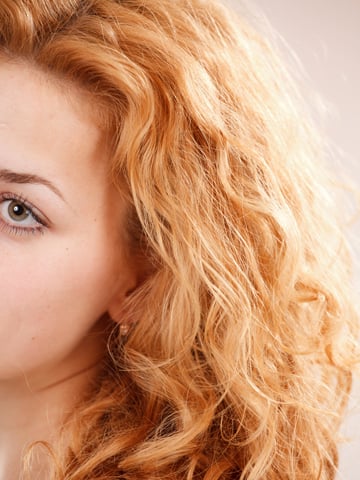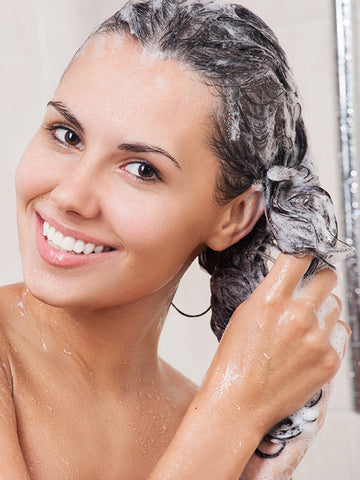
Often confused for thick or curly hair, coarse hair is a unique hair texture that, with the right care, can yield healthy and luscious locks. The concerns associated with coarse hair include dryness, frizz, and stubbornness. However, with the proper routine and products, you can be the source of major hair envy.
What is Coarse Hair?
Coarse hair can be identified by a thick hair shaft. This hair texture has the widest and largest circumference of any other. Unlike thin or medium hair, coarse hair contains all three layers of the hair shaft — cortex, cuticle, and medulla.
If you don’t know which type of hair texture you have, a great way to find out is by rolling a strand between your fingers. If the strand feels thick between your fingertips, you probably have coarse hair. Another way to identify whether or not you have coarse hair is by comparing the thickness of one strand to that of a piece of sewing thread. If the hair strand is thicker than the thread, you have coarse hair.
What’s the Difference Between Coarse and Thick Hair?
Coarse hair and thick hair are often mistaken as interchangeable. However, they refer to different characteristics of your hair:
- Thick hair refers to the hair density, or the number of follicles on the scalp
- Coarse hair refers to the circumference of the individual strand.
It’s possible to have thin and coarse hair just like it’s possible to have thick and fine hair. Hair density and hair texture are different and we all have some combination of the two. Knowing your combination is beneficial when it comes to establishing an effective hair care regimen.
What Are the Best Products for Coarse Hair?
|
Potion 10 Miracle Repair Conditioner The intense conditioning properties of the Potion 10 Miracle Repair Conditioner penetrate the coarse hair shaft in order to infuse your locks with vitamins and nutrients. This protects the hair from drying out throughout the day. |
Silk Express Miracle Silk Hair Mask The Silk Express Miracle Silk Hair Mask transforms the texture of your hair by softening and moisturizing each strand. If your coarse hair tends to feel dry and rough, this mask will infuse a silky texture into your hair, making it more manageable. |

|
Potion 10 Miracle Repair Conditioner The intense conditioning properties of the Potion 10 Miracle Repair Conditioner penetrate the coarse hair shaft in order to infuse your locks with vitamins and nutrients. This protects the hair from drying out throughout the day. |
|
Silk Express Miracle Silk Hair Mask The Silk Express Miracle Silk Hair Mask transforms the texture of your hair by softening and moisturizing each strand. If your coarse hair tends to feel dry and rough, this mask will infuse a silky texture into your hair, making it more manageable. |
How to Care for Coarse Hair
It’s important to familiarize yourself with the best way to take care of your coarse hair: which hair products to use, which ingredients to avoid, when and how to wash your hair, and the best styling options.
Look For the Right ProductsWhen it comes to products, look for those specifically meant for coarse hair, as these will have moisturizing properties that penetrate the outer layer of the hair shaft. Shampoo your hair gently, slowly working it into your hair. Rough rubbing may cause frizz or tangles when you get out of the shower.
As for conditioner, apply this on the ends first and work upward. If your scalp gets oily easily, do not bring the conditioner all the way up to the scalp. Try washing your hair about twice a week. Washing more than that may prevent your scalps natural oils from traveling down to your ends. Over a period of time, this will result in dried out hair.

If your coarse hair is prone to dryness, you may want to try co-washing. Common among the curly-haired, co-washing is when you only wash your hair with conditioner. The conditioner rinses the dirt out of your hair while preventing dryness and moisturizing at the same time. After the shower, apply a hair serum or hair oil on the ends and middle of your hair, avoiding the scalp area. This will help to nourish your hair before the natural oils from your scalp present themselves. Look for a serum specially made for dry hair or coarse hair.
Keep It HealthyFinally, make sure to keep the ends of your hair fresh and healthy. Trimming your ends every 6-8 weeks is a great way to ensure your split ends aren’t traveling up the hair shaft. If you can, find a stylist that has experience working with coarse hair, because they will be more knowledgeable about the types of products to use on your hair, and how to best trim your hair.
Common Coarse-Hair Concerns
While coarse hair has its upsides, there are also a few concerns that arise with this hair texture.
Dry HairSince coarse hair includes all three layers of the hair shaft, moisture has a longer journey when it comes to penetrating deeply into the hair. This may result in a rough texture and damaged, dull looking hair. When searching for a solution, it’s important to keep in mind that coarse hair needs to be treated differently from fine or medium hair.
- Use a deeply moisturizing hair mask on your hair at least once per week. The hair mask should include moisturizing oils heavy enough to saturate your hair effectively but light enough so that the oil is able to penetrate the hair shaft. Avoid using the mask more than once per week, as build up may start to occur.
- If possible, avoid blow drying your hair. This literally blows the moisture out of your hair and it can take your hair’s natural oils along with it. Instead, try planning ahead and giving your hair plenty of time to air dry. When your hair is slightly damp, apply a light moisturizing oil. Over time, your hair will start to recover from previous blow dry damage.
- If you find that at-home treatments and masks are not making a difference in your dry hair, your hair may need a salon treatment to catalyze its recovery. Visit your trusted stylist and they will decide which treatment is right for your hair.
Frizziness in coarse hair can be the result of over-washing or over-processing. If your hair tends to be naturally frizzy, humidity may increase the frizz, making your hair difficult to manage.
- Try limiting the amount of heat you use on your hair. Too much heat can cause the hair to break, which most often results in frizz in coarse hair. When you do use heat, always use a thermal protectant spray or serum and turn down the heat on the tool as much as possible (while still maintaining its function). Hot tools tend to dry out ends because the heat evaporates the hair’s oils. When you use heat on your hair, make sure to apply an oil or light serum to the ends of your hair to prevent prolonged damage and frizzy ends.
- If you tend to wake up with frizz, try replacing your pillowcase with a silk one. Silk tugs at your hair less during the night, especially if you toss and turn. This results in less breakage and abrasion, which helps to reduce frizz.
- Brushing your hair regularly with a natural bristle brush can help distribute the oils from your scalp to your ends, which protects against frizz and humidity. Only do this with straight hair, as brushing curly hair can make frizz worse.
Whether you have deemed your hair dry, frizzy, or oily, you have probably come up with a solution or treatment you want to try. Since coarse hair is made up of all three layers of the hair shaft, it is not easily penetrable. These treatments need to be extra strong or specially made to penetrate the shaft in order to be effective.
- When using an oil or deep conditioning treatment, wear a shower cap and sit under a hooded dryer. When the treatment is warm, it is more likely to soak into the hair.
- Don’t be afraid to use heavier leave-in conditioners and creams in your hair. Since coarse hair tends to be more stubborn, using a stronger treatment is appropriate and your hair will not be weighed down as easily as fine or medium hair.
Best Haircuts and Styles for Coarse Hair: How to Style Coarse Hair
When styled right, coarse hair can provide the perfect foundation for a full, luscious hairstyle. Since coarse hair gives off a thicker appearance, avoid blunt lines when getting it cut. Soft, framing layers work best for complementing your hair's texture.
Since your hair gives you more substance to work with, don’t be afraid to try out creative braids and updos! Fishtail braids, twists, French braids, and half-up-half-down styles can be perfect for work or social events, while more casual settings may call for simple buns or ponytails (which will appear fuller because of your coarse hair texture).

